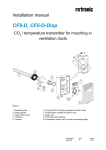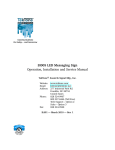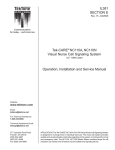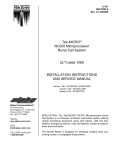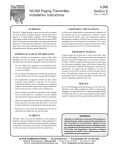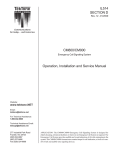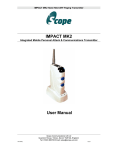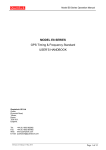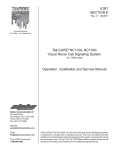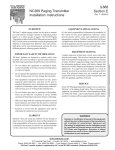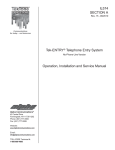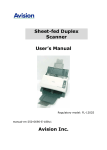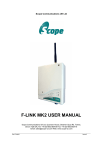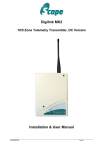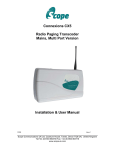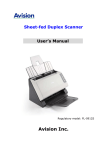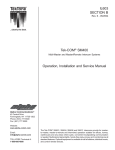Download IL677 NC371A Manual - Alpha Communications
Transcript
® IL677 Rev. 2 - 09/99 NC371A Telepath 450 User Manual for On-Site Paging System World Wide Web Site: www.alpha-comm.com Email: [email protected] For Technical Assistance: 1-800-666-4800 Alpha Communications® 42 Central Drive Farmingdale NY 11735-1202 Phone: 631-777-5500 Fax: 631-777-5599 TABLE OF CONTENTS 1.0 IMPORTANT SAFETY INFORMATION .................................................................. 1 1.1 LIABILITY .......................................................................................................... 1 1.2 EQUIPMENT APPLICATIONS.......................................................................... 1 1.3 EQUIPMENT TESTING ..................................................................................... 1 1.4 LITERATURE ..................................................................................................... 2 1.5 LICENSE .............................................................................................................. 2 2.0 SYSTEM DESCRIPTION ............................................................................................ 3 2.1 RANGE ................................................................................................................ 3 3.0 INSTALLATION INSTRUCTIONS ........................................................................... 4 3.1 UNPACKING....................................................................................................... 4 3.2 SETUP .................................................................................................................. 4 4.0 OPERATION OVERVIEW ......................................................................................... 5 4.1 DRY CONTACTS ............................................................................................... 5 4.2 PAGER SETUP .................................................................................................... 5 4.3 RANGE CHECK .................................................................................................. 5 5.0 PAGING INSTRUCTIONS ......................................................................................... 6 5.1 NUMERIC PAGING............................................................................................ 6 5.1.1 GROUP PAGE ............................................................................................ 6 5.1.2 DRY CONTACT PAGE ............................................................................. 7 5.1.3 TONE ONLY PAGE ................................................................................... 7 5.1.4 TELEPHONE OPERATION ...................................................................... 7 6.0 SPECIFICATIONS ....................................................................................................... 8 6.1 PERFORMANCE ................................................................................................ 8 6.2 SERVICE ............................................................................................................. 8 PROBLEM HINTS ............................................................................................................. 8 APPENDIX A: PROGAMMING PROCEDURES ................................................................................ 9-10 WARRANTY .................................................................................................................... 11 1.0 IMPORTANT SAFETY INFORMATION TekTone® products are designed to operate safely when installed and used according to general safety practices. The following requirements should be observed at all times. Do NOT subject this equipment to: 1) Mechanical shock 2) Excessive humidity or moisture 3) Extremes of temperature 4) Corrosive liquids · · · · This equipment is designed for indoor use only, unless expressly stated otherwise, and must not be used in classified Hazardous Areas, including areas containing explosive or flammable vapors, unless express authorization has been given in writing by the manufacturer. Do not obstruct any slots or openings in the product. These are provided for ventilation to ensure reliable operation of the product and to protect it from overheating. Only use a damp cloth for cleaning (not liquid or aerosol based cleaners), and ensure the AC adapter is removed from the unit prior to beginning the cleaning operation. Removal of covers from the equipment must only be undertaken by authorized service personnel. Warning! Alteration or modification to any part of this equipment, without the prior written consent of the manufacturer, will invalidate all manufacturer Approvals and Warranties. No adjustments can be undertaken except by a qualified and licensed person as defined by the FCC Rules and Regulations. Operation of altered equipment can result in fines, imprisonment, and/or confiscation of such equipment. 1.1 LIABILITY TekTone® does not accept any liability for any damage or injury howsoever resulting from misuse of this equipment. It is the responsibility of the user to ensure that the equipment is operated in the manner for which it was intended and that it is the correct item of equipment for the required task. 1.2 EQUIPMENT APPLICATIONS It is the user’s responsibility to determine the suitability of the NC371A for any given application. Neither TekTone®, nor any of its subsidiaries, can provide specific advice, as each application will require independent evaluation. The following information, however, may be of benefit. working range so as to ensure a measure of safety. TekTone® suggests that a log should be kept of all the test dates and the information gathered, together with the battery change data and service records. The frequency of the tests required will vary between applications. If a pager has been dropped or is worn by a person involved in an accident, the unit should be tested again before re-use. It must be stressed that the physical range tests are essential, and any construction work or movement of plant or equipment could alter the signaling capability of the unit. 1.3 EQUIPMENT TESTING Range tests should be carried out at least once a week, more often when critical criteria apply. They should involve testing the unit past the limit of its required 1 1.4 LITERATURE TekTone® has a policy of continual improvement, and therefore reserves the right to modify or change the specifications without prior notice. While every possible care has been taken in the preparation of this manual, TekTone® shall not be liable for technical or typographical errors or omissions contained herein, nor for incidental or consequential damage arising from the use of this material. Copyright © 1999 No part of this document may be photocopied or reproduced in any form without the express written permission of TekTone®. Exclusive Distributor: Inter Page LP 618 N. US Highway One Suite 200 N. Palm Beach, Florida 33408 Telephone: (800) 992-1000 Fax: (561) 844-5844 Manufacturer Scope Marketing (Communications UK) Ltd. Totnes, Devon, England 1.5 LICENSE You are cleared to use this equipment within the USA under a license assigned to the exclusive importer, PIPs Holdings Inc., License number 950415906 issued on 06/ 26/1995 which expires on 06/26/2000. Certain restrictions apply in respect of output power and antenna installations. If you have any queries, contact Inter Page before installation and use. Alternate frequencies are available by formal license application (Form 600) via the FCC. These will not be subject to the same restrictions as the standard assigned license. You should obtain the FCC Rules and Regulations, Title 47, Part 80 to End, including Parts 90 and 95, available from the US Government Printing Office, GPO bookstore or FCC Office. 2 2.0 SYSTEM DESCRIPTION The NC371A has a DTMF interface which will connect to an internal analog telephone extension that is capable of transmitting DTMF tones on all internal telephones. The two volt-free (dry) contacts will provide pre-programmed messages when activated. These contacts can be programmed for “normally open,” “normally closed” or “change of state” operation. 2.1 RANGE The range of the NC371A is approximately one (1) mile. However, the range and performance of this equipment can be improved by the addition of different antennas. These can be installed either inside or outside the building and are connected to the transmitter with 50 ohm coaxial cable. The centerfed halfwave di-pole, measuring approximately 12 inches from tip to tip, will provide excellent local signaling. This can be mounted either inside or outside the building, and is available in either a light weight or heavy duty stainless steel design. When using an antenna such as the 6 dB end fed Colinear, it is intended for external application and will, when elevated, boost overall range with a slight loss to some local signals. Coaxial cable in lengths of 15 feet are available with BNC to N-Type, and N-type to N-type. [High frequencies can equate to high power losses]. Always use the best quality cable. RG58 is only acceptable on cable runs of up to 15 feet. We recommend RG8/U (Belden 9914) or RG213/U (Belden 8267) on lengths exceeding 15 feet. If in doubt, consult our technical department. Coaxial cable intended for TV satellite or CCTV installations is normally 75 ohm and therefore IS NOT suitable for this unit and can cause transmitter damage. 3 3.0 INSTALLATION INSTRUCTIONS 3.1 UNPACKING Carefully unwrap and inventory the NC371A and all components as shown below. If anything is missing, notify TekTone® immediately. 3.2 SETUP 1. Place the NC371A on a flat surface. 2. Connect the antenna to the base unit using the BNC twist lock connector on the end of the antenna. Insert and twist clockwise to lock in place on the left side of the NC371A. Slide the plastic cover over the connector, engaging the two lugs into the corresponding recesses on the side of the case. (See Figure 1.) NC371A 3. Ensure the two jack plugs are installed (DC1 and DC2). Even if they are not wired to a switch, removal will trigger the unit when it is first powered up (unless the contacts have been programmed out). (See Figure 2.) AC Adapter 12VDC 4. Connect the AC adapter supplied with the unit to the base station by inserting the plug into the “power in” jack at the rear of the NC371A. (See Figure 2.) Important note: Use only the power supply supplied with your system! The use of non-approved supplies will invalidate all warranty and service. UHF Antenna POWER IN 12V DC Figure 1 4 PL1 TEL. INTERFACE (OPTIONAL) DC2 DC1 Figure 2 4.0 OPERATION OVERVIEW When the unit is first powered up, the system will display the following screen for a few seconds: SCOPE MARKETING DataPage V1.00 Followed by: 4.1 DRY CONTACTS There are two volt-free (dry) contacts available for use with either “normally open”, “normally closed” or “change of state” switches. When either is triggered, the programmed message(s) will be sent to the selected pager (or group of pagers). When used in the “normally open” mode only, the message will repeat while in the active state (can be used as a safety mode). ENTER PAGER No: > The flashing cursor invites you to enter a pager number (this can be any number between 1 and 9999) after which you must press “ENTER” for the number to be accepted. Pressing the “CANCEL” key at this stage will return the user to the pager number prompt to begin again. Pressing the “SEND” key in place of the “ENTER” key will transmit a tone only message to the pager, using the default beep type . After pressing “ENTER”, the next screen appears, offering a choice of beep types. Again, the flashing cursor invites you to enter a selection. BEEP TYPE (1-4) > Select beep type 1,2,3 or 4, or press “ENTER” without making a selection. This will attach the default beep type to the call. (Not all pager types currently carry the transmitter selectable beep type). In the event that your pagers are so equipped, selecting 1,2,3 and 4 will correspond to beep types A, B, C and D respectively. Pressing the “SEND” key at this stage will send a tone only message, together with the beep type selected. After selecting the beep type, press “ENTER”. The screen will now prompt how you enter a message of up to 20 digits, including parentheses and spaces. Note: the screen will scroll after entering 15 digits. 4.2 PAGER SETUP Remove each pager from its packaging and refer to the documentation accompanying the pager for installation of the battery and operation of the functions of the pagers. Your pagers have been pre-programmed by TekTone® with correct information for use with the NC371A. 4.3 RANGE CHECK Prior to permanently installing the NC371A, you should perform a range study. This will ensure that the location chosen for the installation will give you the optimum coverage by the NC371A. To perform a range study, complete the following steps. 1. Ensure the Jack Plugs are installed in DC1 and DC2. 2. Apply power to the NC371A. 3. Remove the Jack Plug from DC1. 4. A preset page will be transmitted every 10 seconds to pager number 1 (one) or the lowest number pager you ordered. This page will continue until the plug is replaced in DC1. ENTER MESSAGE: > After inputting the message, press “ENTER” or “SEND”. The call will now be transmitted to the pager. Pressing the “CANCEL” key at any stage of operation will immediately revert the unit to the “ENTER PAGER No:” prompt. 5 5.0 PAGING INSTRUCTIONS 1. LCD Display. 2. Numeric keypad for entering pager numbers (1-9999) and messages. 3. Enter key. Enter must be depressed after each entry. 4. Send key. Depress to transmit message. 5. Space key. Enter space between characters (e.g. 999 7777). 6. Cancel key. Cancel previously entered information 5.1 NUMERIC PAGING 1. Enter pager number on numeric key pad 1 to 9999. 2. Depress the “ENTER” key. 3. Select beep type by depressing the numeric keys 1 thru 4. 1=1 beep 2=2 beeps 3=3 beeps 4=4 beeps 4. Depress the “ENTER” key. 5. Enter the message you wish to transmit by using the numeric keypad, space and parentheses. Example: 561 444 9999 5.1.1 GROUP PAGE The NC371A needs no modifications to issue a group page (more than one pager at a time). The required programming is performed on the radio paging receivers at the time of purchase. 1. Enter the number on numeric key pad designated as group call page 1 to 9999. 2. Depress the “ENTER” key. 3. Select beep type by depressing one of the numeric keys 1 thru 4. 1=1 beep 2=2 beeps 3=3 beeps 4=4 beeps 4. Depress the “ENTER” key. 6. If a change to the message is desired, depress the “CANCEL” button. This will clear the input and allow you to re-enter your message. 7. When you are satisfied with your message depress the “SEND” button. Your message will be transmitted to the pager you selected in step 1 of this procedure. 6 5. Enter the message you wish to transmit by using the numeric keypad, space and parentheses. Example: 561 444 9999 6. If a change to the message is desired, depress the “CANCEL” button. This will clear the input and allow you to re-enter your message. 7. When you are satisfied with your message depress the “SEND” button. Your message will be transmitted to the pager you selected in step 1 of this procedure. 5. Enter the message you wish to transmit up to a maximum of 20 characters followed by a # sign. 6. The user will hear a set of sign off tones (High, Low, High, Low). 5.1.2 DRY CONTACT PAGE 7. Replace the handset. The NC371A has two dry contacts. Both contacts are programmable and will be set to the customer’s requirements at the time of purchase. Each contact may be used for emergency calls or to monitor an unoccupied area. If used as an emergency button, the attendant just depresses the switch inserted into one of the Dry Contacts in the rear of the NC371A base unit (DC1 and DC2). The unit will send a preset message to the designated pager. 5.1.3 TONE ONLY PAGE The NC371A can be used to transmit a TONE ONLY signal to any pager selected. 1. Enter pager number on numeric keypad designated as group page “1 to 9999”. 2. Depress the “SEND” key. 5.1.4 TELEPHONE OPERATION 1. Access the NC371A system by dialing the extension number on which NC371A is installed. 2. When the NC371A unit answers, the user will hear tones (Four escalating Low to High tones). 3. Enter the individual pager number or the pager number being used as a group that you want to page, followed by a pound sign (#). Pagers can be programmed to correspond to the telephone extension number of each person. 4. The user will hear a single mid tone. This tells you the pager number was accepted. If the pager number is rejected, the user will hear a low beep. The user must re-enter the pager number. 7 6.0 SPECIFICATIONS Operating Frequency: RF Power output: Deviation: Stability: Operating Voltage: Current Consumption: 457.575 Mhz 400 - 500mw ± 4.5 Khz / 512 Baud ± 2.5PPM over a range of 14° F to 131° F 12 Volts DC 50ma standby, 300ma transmit (500mw) 6.1 PERFORMANCE The system will normally cover 95% of all range requirements using the base station connected antenna, on buildings of 50,000 square feet or less. Greater ranges can be achieved by using an externally mounted antenna (subject to license conditions). Contact TekTone® prior to any antenna change. 6.2 SERVICE If your NC371A or pagers require service, return them to Alpha® at the address listed in the front of this manual. Prior to returning the equipment, you must call Technical Support at 1-800-666-4800. To obtain an RMA number (Return Authorization Number) please contact our Sales Department at 1-800-666-4800. NO RETURNS WILL BE ACCEPTED WITHOUT AN RMA NUMBER. PROBLEM HINTS 8 PROBLEM SOLUTION 1. None of the pagers on the system will respond to a page. 1. (a) Check to be sure your NC371A unit has power. The display will show: ENTER PAGER NO: (b) Check to be sure the antenna is connected to the NC371A unit. 2. Some of the pagers will not respond to a page. 2. (a) Using the wrong pager number (b) Pager is turned off. (c) Pager battery is dead. (d) Pager is out of range. 3. The NC371A base unit display is blank. 3. Check to be sure the NC371A’s (a) AC adapter is correctly connected to the NC371A (b) AC adapter is correctly connected to a 115 volt AC outlet. (c) Ensure the 115 volt AC outlet is “ON”. APPENDIX A: PROGRAMMING PROCEDURES The NC371A is factory pre-set and should not be adjusted by the customer. The factory settings can be viewed for the purposes of verification when ordering additional components. The user MUST NOT alter any data marked [INFORMATION ONLY]. If this information is altered the system will not function properly. The system parameters are protected from accidental change by a password. You can escape from the program at anytime by pressing “CANCEL”. 1. Access the stored program a. Enter the default password [ (72765 ]. b. Press “ENTER ”. b. Enter the number of dry contacts required. 0 = None, 1 = DC1, 2 = DC1 and DC2 c. Press “ENTER”, the screen will display: 2. If the system accepts the password the screen will change to: 1. SETUP 3. PHONE 2. INPUTS 4. SERIAL 3. Select 1 “SETUP”. [ INFORMATION ONLY DO NOT CHANGE ] ACTIVATE STATE: :Normally Open d. Select the condition of activation for the dry contact. 1 = Normally Open 2 = Normally Closed 3 = Change of State e. Press “ENTER”, the screen will display: BASE PAGER ID: >10000 TRIG. TIME 0-15: > a. Press “ENTER ”. The screen will change to: DEFAULT BEEP: >1 b. Select a number 1 through 4 which corresponds to the pager beep codes of “A”, “B”, “C”, and “D” respectively. Note: not all pagers are equipped to respond to transmitted codes. c. Press “ENTER” to confirm, or “CANCEL” to return to the start. d. If you press “ENTER”, the screen will display: [INFORMATION ONLY DO NOT CHANGE ] TRANSMIT SPEED: 512 bps e. Press “ENTER ”. 4. Select 2 “INPUTS ” a. The Screen will change to: f. This indicates the time that the contacts must remain in the active state to effect a trigger. A value of between 0 and 15 can be entered. Each number represents 0.25 seconds (approximately). Therefore, a value of 14 would equal 3.5 seconds. Enter Trigger Time and press “ENTER”. The screen will display: REPT. TIME 0-15: > When the contact is set for Normally Open mode the message will be repeated while the contact remains in the closed state. This screen allows you to select the time gap between each repeat transmission. Each number represents a block of 10 seconds. g. Enter Repeat Time and press “ENTER”. the screen will display: INPUT 1 PAGER: > INPUT COUNT 0-2 > 9 1. Enter the Pager Number you wish to activate when dry contact one (DC1) is triggered. 2. Press “ENTER”, the screen will display: INPUT 1 TONE: > 3. Enter a number between 1 and 4 to set the beep type. 4. Press “ENTER”, the screen will display: INPUT 1 MESSAGE: > 5. Type the numeric message you wish to appear on the pager. 6. Press “ENTER”. If you have selected two dry contacts, then you will be prompted for the same information for dry contact (DC2). When completed, the screen will revert to the main programming menu. 6. Select 4 “SERIAL” This connection is reserved for advanced programming and for special applications. It is not accessible to the user. 7. Changing your PASSWORD. a. At the main programming menu screen, press ( b. Screen will change to: ENTER PASSWORD: ? c. Type in current password and press “ENTER” d. Screen will change to: NEW PASSWORD: ? e. Type in new password and press “ENTER”. f. Screen will change to: CONFIRM PASSWORD: ? 5. Select 3 “PHONE” a. The screen will change to: RINGS TO ANSWER: >1 b. Enter a number in the range of 1 to 9. This will define the number of rings before the system will pickup the line. c. Press “ENTER”, the screen will display: INACT’V TIMEOUT: >10 d. Enter a number in the range of 2 to 99 seconds. This is the time after which the line will be dropped if there is no activity. e. Press “ENTER”, the screen will display: ANS TONE DELAY: >2 f. Enter a number between 1 - 99. Each number is 0.1 seconds (approximately). This will adjust the delay time from the moment the line is picked up to the time that the “sign on” tones are generated. g. Press “ENTER”. 10 g. Re-type the new password and press “ENTER”. h. Screen will change to: PASSWORD UPDATED OK i. j. The new password is now successfully stored. To return to the pager entry screen, press “ENTER” or “CANCEL” when at the main programming menu. WARRANTY TekTone® warrants that your NC371A is free from defects of workmanship and materials. If there is a defect or malfunction of this product, TekTone® will repair or replace it free of charge, with proof of purchase, for one year from date of original purchase. This warranty does not include adjustments, parts, and repair by circumstances beyond the control of TekTone®, including, but not limited to fire or other casualty, accident, neglect, abuse, abnormal use, or battery leakage damage. There are no other expressed warranties except as stated herein. After the period of the expressed warranty set forth herein, there are no additional expressed or implied warranties, and those excluded include those of merchantability and fitness for a particular purpose. In no event will TekTone® or any of its agents be liable for direct, indirect, special, incidental, or consequential damages resulting from any defect in the product, even if advised of the possibility of such damages. The warranty and remedies set forth above are exclusive and in lieu of all others, oral or written, expressed or implied. No TekTone® distributor, dealer, agent, or employee is authorized to make any modification, extension, or addition to this warranty. Some states do not allow limitations on how long an implied warranty will run and some states do not allow exclusions or limitations of incidental or consequential damages. To obtain service under the terms of this warranty, contact TekTone® and follow explicit instructions. Copyright© 1999 No part of this document may be photocopied or reproduced in any form without the express written permission of TekTone® Sound & Signal Mfg., Inc. 11













